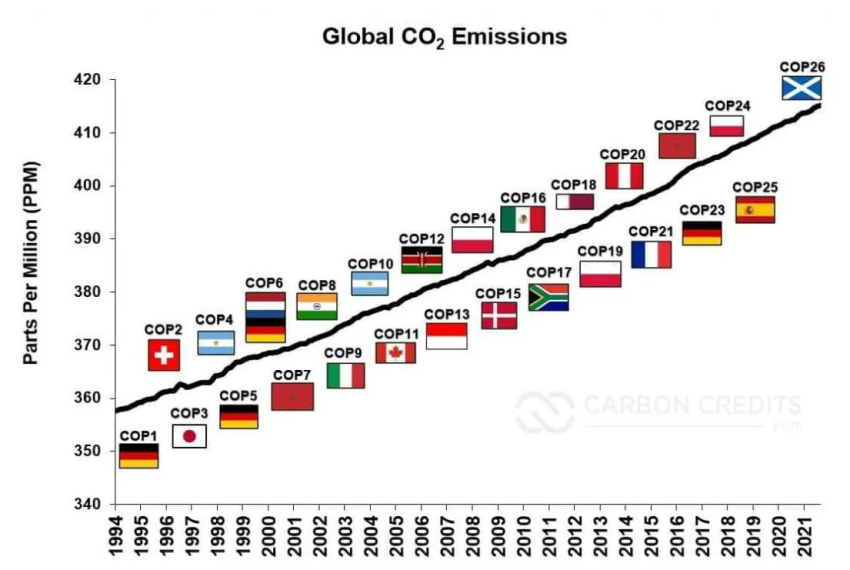
If there was shock and awe recently when the Copernicus Climate Change Service announced that global average warming over the past 12 months — February 2023 to January 2024 — had exceeded 1.5°C, it was likely because too many people had succumbed to the predominant, but delusional, policy-making narrative that holding warming to 1.5–2°C was still on the cards.
What does this symbolically important moment mean for the poor understanding of climate-risk analysis by Australian governments?
To begin, the idea that emissions could continue till 2050 and still achieve the 1.5–2°C goal was always a con; now it is fully exposed.
One year of 1.5°C does not constitute a trend, which technically can only be seen in retrospect over 20 to 30 years of data.
But with another hot year likely in 2024, the rate of warming accelerating and a current peak in the Earth’s Energy Imbalance — which is an indicator of future warming — it is hard to disagree with the assessment of former NASA climate science chief James Hansen that the world has now reached the 1.5°C mark for all practical purposes.
When the 2015 global climate conference resulted in the Paris Agreement’s commitment to hold climate warming to the 1.5–2°C band, those numbers quickly became normalised as the sine qua non of climate policymaking.
But that was a grand illusion on two counts. The first was that 1.5°C was a safe or appropriate target.
Sir David King, a former British Chief Scientist, had collaborated with the small island states in the lead-up to the Paris conference in pushing the 1.5°C goal. But in 2021, The Independent journalist Donnachadh McCarthy reported that King “astounded me by saying he now realised this was wrong, and believes the passing of the Arctic tipping point has already been reached …
“He said the 1.1°C rise that we already have is too dangerous — and candidly admitted he believed US climate professor James Hansen had been right after all in 1988, when he warned the US Congress that we should not pass 350 [parts per million] ppm. We have now [in 2021] breached 415 ppm and are heading fast towards 500ppm.”
The second illusion was that there was any realistic hope of keeping warming to 1.5°C, or even 2°C, given the decades of policy-making failure (see image below), emissions breaking new records year after year, the reduced levels of aerosols which are masking warming, the political inertia rooted in adherence to a slow, economically non-disruptive mitigation path and, in particular, state capture by the fossil fuel industry, allowing fossil fuel expansion.

Many of us, including some leading scientists, have been warning for a long time that the world would flash past 2°C and into the existential 3–4°C range given the failure to treat climate change as the single greatest threat to humanity, and respond accordingly.
But policy-makers focused on the scenarios provided by the Intergovernmental Panel on Climate Change (IPCC), which is charged with presenting policy-relevant science; that is, science for politically-appointed policy makers.
The 2018 IPCC Special Report on Global Warming of 1.5°C said that global temperature was currently rising around 0.2°C per decade, and “if this pace of warming continues, it would reach 1.5°C around 2040”.
The more recent, new generation CMIP6 climate models, using an emissions scenario closest to current circumstances showed 1.5°C between 2026 and 2042, with a median of 2032.
These sets of numbers created a comfort zone for policymakers (“it could be 20 years away”) that are at odds with the reality now unfolding.
Warming rate doubling?
Hansen warned in 2021 that the rate of global warming over next 25 years could be double that of the previous 50 and, in 2023, he pointed to clear evidence that this acceleration was now happening.
Some were initially sceptical but, as records continue to be smashed month after month, it is now more widely appreciated that the warming rate is at least 50% higher than earlier decades, at 0.3°C per decade.
Celeste Saulo, the new chief of the World Meteorological Organisation (WMO), said on February 7 that the rate of human-caused climate change is accelerating, based on research by some WMO science teams. She was concerned, not knowing what it means for the future: “We are not there in terms of our scientific understanding of the implications of this acceleration. We don’t fully understand how it is going to evolve.”
That should be a real worry for the Australian government too, in this hottest and driest continent.
That acceleration moves forward the timeline for reaching 2°C of warming, for the manifestation of more severe impacts and for systemic tipping points.
Hansen warned that warming will accelerate to 1.7°C by 2030. In comparison, current modelling reflected in IPCC reports show temperatures “are expected to pass 2°C in the modest-mitigation SSP2-4.5 scenario — where emissions remain around current levels — between 2038 and 2072, with a median year of 2052.
Advice to the Australian government from the sclerotic Climate Change Authority, reports from CSIRO and the current, domestically-focused, National Climate Risk Assessment (NCRA) all use the IPCC work as the bedrock of their work and advocacy.
This is now a disaster, because warming may be 15 years ahead of the IPCC’s outdated analysis and its history of reticence on tipping points.
The NCRA is still using a 1.5–2°C by 2050 scenario, Department of Climate Change Deputy Secretary Jo Evans told Greens Senator Larissa Waters at Senate Estimates on February 12.
“I don’t understand why you are doing a risk assessment based on a scenario that’s so below what’s actually going to happen. That doesn’t give you an adequate picture of risk. Isn’t the whole point of doing this risk analysis to understand what the risks are?” Waters asked.
“We don’t think it’s unrealistic. You are expressing your take on it,” Evans replied.
And that’s the problem. The government simply isn’t up to speed, and its risk assessment process is out of time.
Hansen’s analysis doesn’t have to be exactly right for his conclusion to be taken very seriously as a plausible worst-case scenario — though he has not been substantially wrong on any of the big issues in a career spanning 50 years.
Such a scenario should play a prominent role in generating climate advice to governments, because when risks are existential — as climate minister Chris Bowen has accepted — it is important to give particular attention to the plausible worst-case or high-end scenarios.
Precautionary action needed
That is where the damage is greatest, and we do not get a “second chance” to learn from our mistakes when a risk is civilisation-ending.
Thus the urgency for precautionary action to ensure these scenarios never occur.
Professor Matt King, head of the Australian Centre for Excellence in Antarctic Science, said in January he found it embarrassing how little was known about the local and global ramifications of Antarctic changes, “including a historic drop in floating sea ice cover, the accelerating melting of giant ice sheets and the slowing of a deep ocean current known as the Southern Ocean overturning circulation”, which may threaten the viability of some Australian agriculture sectors amongst many adverse impacts.
With warming way ahead of the IPCC view, extreme events astounding scientists as they reach way outside the model projections, inadequate understanding of how a destabilising jet stream is magnifying heat and rain bomb extremes and worries about faster-than-forecast tipping points, including a new study that suggests the Atlantic overturning circulation (AMOC) “is on tipping course”, any government focussed on protecting their people from unexpected and catastrophic impacts would commission an urgent review of this fast-changing landscape.
Bob Berwyn from Inside Climate News reported the author of a 2023 AMOC paper, Peter Ditlevsen, as saying that a collapse of the heat-transporting circulation is a going-out-of-business scenario for European agriculture.
Given the way Australia’s public service has been gutted of climate expertise, the sad state of CSIRO and the methodological mess into which the NCRA has fallen, an urgent review would be best led by an independent, eminent scientist, or scientists, who can give analysis and advice free of the turf wars, the silos and the culture of failure so evident within government structures, and of the dead hand of the fossil fuel industry.
It could be a similar role to that played by Ross Garnaut on the economics of climate change.
Some questions the climate minister could reasonably be asked today now include:
1. What specific advice has the minister received on the magnitude of the warming acceleration and on the implications for impacts and policy-making in Australia over the next 20 years?
2. Will the scientific inputs to the NCRA be revised in light of this recognition of accelerated warming and will new modelling be done to accommodate these changed circumstances?
3. How will the Antarctic changes identified by Matt King be incorporated into the NCRA, especially for food production?
4. Is the NCRA giving particular attention to a plausible worst-case scenario? In such a scenario, what level of global warming to 2050 would we be looking at?
5. Chatham House’s 2021 Climate Risk Assessment identifies a high-end scenario as warming of 3.5°C or more this century. Will the NCRA be specifically looking at such a scenario?
6. What precautionary action will be taken to head off this looming national climate catastrophe?
Given the performance in Senate Estimates recently, it is not easy to be optimistic about the government’s response.
[David Spratt is Research Coordinator for the Breakthrough National Centre for Climate Restoration (Naarm/Melbourne). Ian Dunlop was formerly an international oil, gas and coal industry executive and is a member of the Club of Rome and Chair and Executive Committee member of the Australian Security Leaders Climate Group. This article was first published at Pearls and Irritations and is reprinted with permission.]